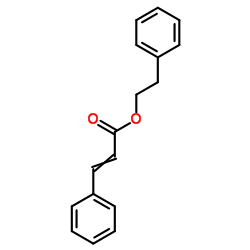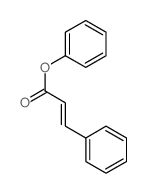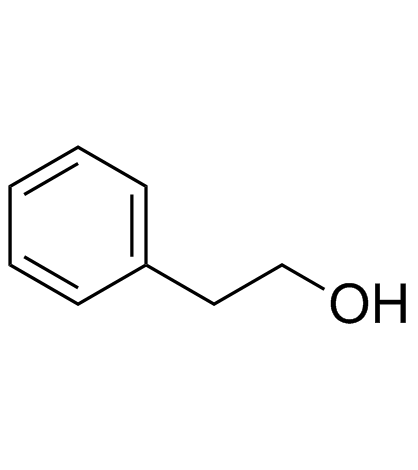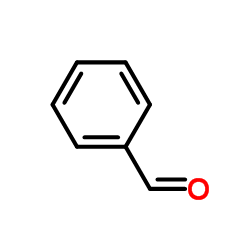2-Phenylethyl 3-phenylacrylate
Modify Date: 2025-08-22 18:57:28

2-Phenylethyl 3-phenylacrylate structure
|
Common Name | 2-Phenylethyl 3-phenylacrylate | ||
|---|---|---|---|---|
| CAS Number | 103-53-7 | Molecular Weight | 252.308 | |
| Density | 1.1±0.1 g/cm3 | Boiling Point | 405.9±24.0 °C at 760 mmHg | |
| Molecular Formula | C17H16O2 | Melting Point | 54-56 °C(lit.) | |
| MSDS | Chinese USA | Flash Point | 254.2±14.0 °C | |
| Symbol |

GHS07 |
Signal Word | Warning | |
| Name | Phenethyl Cinnamate |
|---|---|
| Synonym | More Synonyms |
| Density | 1.1±0.1 g/cm3 |
|---|---|
| Boiling Point | 405.9±24.0 °C at 760 mmHg |
| Melting Point | 54-56 °C(lit.) |
| Molecular Formula | C17H16O2 |
| Molecular Weight | 252.308 |
| Flash Point | 254.2±14.0 °C |
| Exact Mass | 252.115036 |
| PSA | 26.30000 |
| LogP | 4.37 |
| Vapour Pressure | 0.0±0.9 mmHg at 25°C |
| Index of Refraction | 1.598 |
| InChIKey | MJQVZIANGRDJBT-VAWYXSNFSA-N |
| SMILES | O=C(C=Cc1ccccc1)OCCc1ccccc1 |
CHEMICAL IDENTIFICATION
HEALTH HAZARD DATAACUTE TOXICITY DATA
|
| Symbol |

GHS07 |
|---|---|
| Signal Word | Warning |
| Hazard Statements | H315-H319-H335 |
| Precautionary Statements | P261-P305 + P351 + P338 |
| Personal Protective Equipment | dust mask type N95 (US);Eyeshields;Gloves |
| Hazard Codes | Xi:Irritant |
| Risk Phrases | R36/37/38 |
| Safety Phrases | S26-S36 |
| RIDADR | NONH for all modes of transport |
| WGK Germany | 2 |
| RTECS | GE0405000 |
| HS Code | 2942000000 |
| HS Code | 2942000000 |
|---|
|
Caffeic Acid phenethyl ester: consequences of its hydrophobicity in the oxidative functions and cytokine release by leukocytes.
Evid. Based. Complement. Alternat. Med. 2014 , 793629, (2014) Numerous anti-inflammatory properties have been attributed to caffeic acid phenethyl ester (CAPE), an active component of propolis. NADPH oxidases are multienzymatic complexes involved in many inflamm... |
| 2-Phenylethyl 3-phenylacrylate |
| MFCD00022050 |
| Phenethyl cinnamate |
| Cinnamic Acid 2-Phenylethyl Ester |
| 2-Propenoic acid, 3-phenyl-, 2-phenylethyl ester |
| 2-Phenylethyl Cinnamate |
| EINECS 203-120-3 |
| 2-phenylethyl 3-phenylprop-2-enoate |
| Cinnamic Acid Phenethyl Ester |
 CAS#:2757-04-2
CAS#:2757-04-2 CAS#:60-12-8
CAS#:60-12-8 CAS#:33603-90-6
CAS#:33603-90-6 CAS#:140-10-3
CAS#:140-10-3 CAS#:103-63-9
CAS#:103-63-9 CAS#:100-52-7
CAS#:100-52-7 CAS#:102-92-1
CAS#:102-92-1
